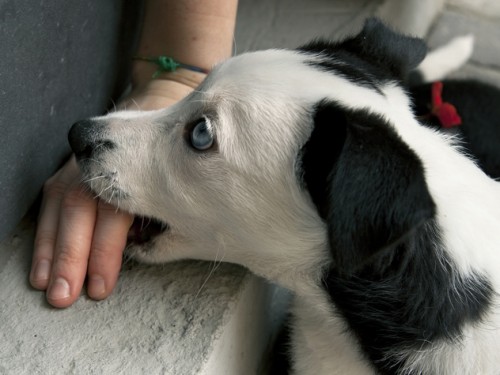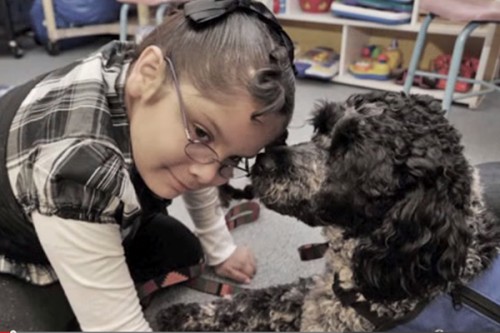How to Stop Dog Mouthing

What is Mouthing?
“Mouthing is when a dog puts his teeth and mouth over a person’s skin while using little or no pressure from his jaw, says dog trainer and expert Mikkel Becker onVetstreet.com. “It’s not to be mistaken for aggressive biting, which is done out of fear or frustration.”
While mouthing may not be an aggressive behavior, it’s still frustrating and your dog could unintentionally hurt or scare someone, or the behavior could escalate into a bite.
Certified pet behaviorist and author Amy Shojai suggests using a two-pronged approach to curbing your dog’s mouthing behavior, starting with teaching “bite inhibition.”
Bite Inhibition
“Bite inhibition is a dog’s ability to control the force of nipping and mouthing,” according to Vetstreet.com. “A dog who hasn’t learned bite inhibition doesn’t recognize the sensitivity of human skin, so the dog nips and mouths too hard, even when playing.”
Puppies and young dogs typically learn bite inhibition during play with other dogs, according to author and dog expert Jennifer Bridell. When dogs play, they frequently use their mouths. If one dog bites too hard, the bite victim yelps and stops playing. This usually gives the biting dog pause. This is how dogs learn to control the force of their bites. Biting too hard means play time stops, and no one wants that to happen.
Amy Shojai recommends people use a similar approach when trying to teach their dog bite inhibition . The basic idea is to reward the desired behavior and redirect or ignore the unwanted behavior. This training will take patience and time, and the best results might come with working with a Certified Professional Dog Trainer or behaviorist.
Teaching Bite Inhibition
People can use strategies similar to puppy play to teach their dogs bite inhibition:
Allow your dog to mouth you during playtime.
Continue playtime until he bites hard.
When he bites hard, let out a puppy-style yelp, and then promptly stop “playing” by letting your hand go limp.
This should cause your dog to pause. When he does, praise him enthusiastically and resume play as normal.
Repeating this over and over should help him get the message. If it doesn’t, you can introduce brief time outs by stopping play all together and walking away after you yelp. After 20 seconds or so of calm behavior from your cutie, return to him and play with him again. This helps teach him that painful play is “bad,” and gentle play is “good.” Gentle play buys him more playtime, while painful play ends it. No fun there.
Continue this sequence. You should notice your dog’s bites progressively getting gentler and gentler – until they have little to no pressure.
After you’ve helped your dog learn to be gentle with his mouth, it’s time to teach him not to mouth people at all.
Teach Your Dog to Stop Mouthing
The experts at Vetstreet.com recommend the following techniques for getting your dog to stop mouthing you and other people:
Substitute a toy or chew bone when your dog mouths.
When you stroke your dog, offer him tasty treats from your other hand to discourage mouthing you as you pet him.
Encourage non-tactile games like tug-of-war instead of rough play , such as wrestling.
Help your dog learn to manage his impulses through activities such as “Leave it” and “Sit.”
If your dog likes to “ambush” your feet or ankles, stop moving as soon as he does this. Then, distract him with a toy. When he grabs the toy, continue moving.
Provide your dog with regular playtime sessions alongside other well-behaved canines. This can tire him out and make him less interested in strenuous play (and therefore mouthing behaviors) with you.
Common Dog Breeds for Degenerative Myelopathy

Breed Disposition
Degenerative myelopathy most often occurs in German shepherds and Welsh corgis. Other breeds predisposed to degenerative myelopathy include American Eskimo dogs, Bernese mountain dogs, borzois, boxers, Chesapeake Bay retrievers, golden retrievers, great Pyrenees, Kerry blue terriers, poodles, pugs, Rhodesian Ridgebacks, Shetland sheepdogs, soft-coated wheaten terriers and wire fox terriers.
DNA Testing
Researchers have identified the DNA mutations responsible for degenerative myelopathy. DNA tests are available to identify if a dog is clear, a carrier or are at increased risk for disease development. Talk to your veterinarian about the benefits of DNA testing.
Healing Puppy Power Put to Test for Childhood Cancer
Joshua sits on a hospital bed sobbing, surrounded by two nurses trying to insert an IV needle and by his Mom and Dad, trying their best to calm their scared and frightened four-year-old. But on this 6 a.m. Monday morning Josh, weary of his cancer battle, will have none of it. There have been too many needles. Now he is getting prepped for a third surgery. Joshua is a scared little boy and he knows what is coming, and he lets everyone within earshot know it.
Standing just outside the hospital room door I lift up my little therapy dog, Gordon, and we peek in. Immediately Josh’s Mom spots us, her eyes lighting up and she exclaims: “Josh, look, it’s Gordon! Gordon is here to see you.’’ They wave us in. Barely a minute or two later Josh is petting Gordon, sobs ebbing now into sniffles, focusing in our direction and his fluffy terrier pal, hardly noticing the IV connection being made on his other side.
A little dose of therapy dog can calm crying children, and ease the trauma and torment that sometimes comes with healing, for the patients, their families and the medical staff. A dog can make a sterile hospital room seem more like home, encourage kids who need to walk after surgery to get up and escort the pup around the hospital corridors, or just relieve the boredom of being stuck in a hospital room instead of being out with friends running around a playground.
In more than 6 years of making hospital visits with my wife Vicki, a longtime pediatric cancer researcher, and with our two therapy dogs, Gordon and Gypsy, we have seen them bring real therapy to thousands of people, both kids and adults. But until now there has been almost no real scientific “proof’’ of what therapy dogs contribute to healing, physical or mental.

That may soon change.
The American Humane Association has teamed up with Zoetis and the Pfizer Foundation to launch a 15-month study designed to document the specific medical, behavioral, and mental health benefits animal-assisted therapy may have for children with cancer and their families.
“American Humane Association has a history of wanting science backing our initiatives,’’ says Amy McCullough, AHA’s National Director of Animal-Assisted Therapy. “In terms of animal therapy, obviously there is a gap there in terms of science supporting the benefits that we know sort of anecdotally that therapy dogs are giving us. With our mission being about helping both children and animals, we saw the need for this study to really promote how therapy dogs can help children who are dealing with cancer.’’
In exhaustive preliminary research, including a review of existing literature and a pilot study at two children’s hospitals, AHA found “therapy dogs are really important in pediatric oncology settings, and they aren’t allowed to visit necessarily in all children’s hospitals in these units, but the ones that we talked to really talked about the benefits.’’

The full clinical trial will seek to confirm benefits identified in the pilot study, including:
Kids with cancer who are visited by therapy dogs have less stress, anxiety, and an improved, health-related quality of life
“Children with cancer and their families are not just dealing with physical concerns, there are also psychological issues – depression, anxiety, loneliness, being away from their classmates and school,’’ McCullough explains. “So these can have longer-term effects. We really want to show how animal-assisted therapy could be a really promising intervention to help not just the patient but the whole family interacts with the therapy dog, touching so many people there in a stressful situation.’’
Not only do the dogs themselves not get stressed by the visits, in fact the visits are mutually beneficial interactions
“The pilot study shows that post visit, the therapy dogs’ cortisol levels were lower than their baseline, indicating that they did not experience stress after visits,’’ McCullough says. “We also videotape the sessions using an ethogram to code the dogs’ behavior throughout the session, looking for signs of stress, whether it is yawning, lip-licking, looking toward the door, those kinds of things.’’
The five children’s hospitals participating in the study are:
St. Joseph’s Children’s Hospital in Tampa
Randall Children’s Hospital at Legacy Emanuel in Portland
UC Davis Children’s Hospital in Sacramento
UMass Memorial Children’s Medical Center/Cummings School of Veterinary Medicine at Tufts in Worcester/North Grafton, MA
Monroe Carell Jr. Children’s Hospital at Vanderbilt in Nashville
This study is personal to me and my wife. Today and every day, more than 35 children and their families will get a cancer diagnosis. In total, more than 40,000 children in the U.S. undergo cancer treatment each year.





